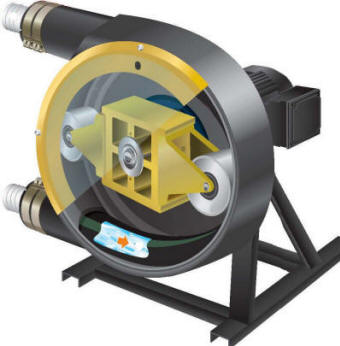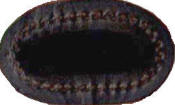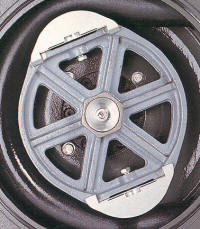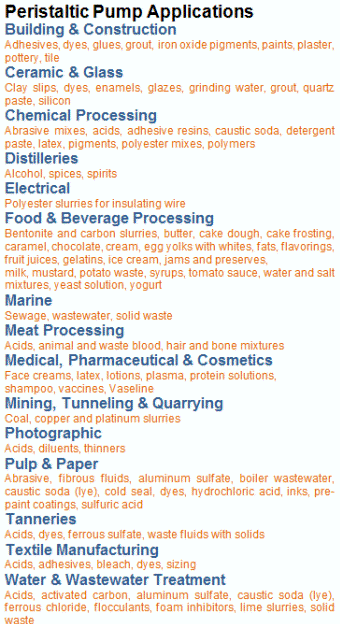Characteristics of Industrial Peristaltic Pumps
Peristaltic hose pump design
 The
peristaltic pump was patented in 1881 by Eugene Allen to be used for blood
transfusions and, although modern industrial peristaltic pumps are much more
efficient and compact than Mr. Allen's patented design, the basic principle
of operation remains the same.
The
peristaltic pump was patented in 1881 by Eugene Allen to be used for blood
transfusions and, although modern industrial peristaltic pumps are much more
efficient and compact than Mr. Allen's patented design, the basic principle
of operation remains the same.
How Peristaltic Pumps Work
The flow rate is
somewhat proportional to the rotational speed with a key variable being the
amount of hose compression. While laboratory size peristaltic pumps
utilize non-reinforced tubing and completely "pinch" the tube to provide
accurate dosing, industrial size peristaltic pumps are not typically
operated in that fashion because the hoses are more rigid and would require
replacement frequently if they were compressed completely.
Therefore, an
industrial peristaltic pump always has some "slip", especially if the
discharge pressure is higher and the fluid has a water-like viscosity.
Thus higher viscosity fluids can be pumped at higher pressures than lower
viscosity fluids when the hose isn't pinched closed 100%.
Peristaltic Pump Hose Design


A peristaltic pump hose needs replacement when the dosed volume decreases to an unacceptable level, which is a reflection of the hose remaining somewhat elliptical shaped even when not being compressed. This "hose fatigue" can eventually result in cracking or delamination of the internal layer if it is a lined hose design. It is preferable to replace a hose before it completely fails, to prevent the process fluid from leaking into and potentially out of the pump.
t is a little known
"industry secret" that most peristaltic pump manufacturers use the same few
hose manufacturers and this is because the hose design is especially
complex. The hoses we provide for our Vector series of peristaltic
pumps will also work in Verderflex® and Watson-Marlow Bredel™
pumps.
 Roller and Shoe Design
Roller and Shoe Design
Shoe designs are capable of higher pressures and therefore the decision for which design is best for a given application is usually both pressure and application based.
Roller designs only
require a light coating of silicon grease on the hose surface because the
roller "rolls" across the hose surface. Therefore applications
involving food and beverages might benefit from this design as the potential
for cross contamination if a hose fails is less than shoe design pumps
bathed in a lubrication oil - even if that oil is "food grade", it is still
often preferable to go with a roller design.
 If
the pressures are not high, the roller design should provide longer hose
life and overall be a more cost effective solution.
If
the pressures are not high, the roller design should provide longer hose
life and overall be a more cost effective solution.
Peristaltic pumps
also do not have internal check valves to control the direction of flow and
therefore can handle relatively large solids and fibrous (long) solids,
which would cause havoc in pumps such as air operated diaphragm pumps that
utilize ball-check valves to control the flow direction.
Since there are no
moving, sliding or rotating components dependent upon the fluid being pumped
for lubrication or cooling, peristaltic pumps can operate dry and are often
used to "suck dry" tanks and totes.
Peristaltic pump
hoses can be replaced with minimal effort - the design of a peristaltic pump
is rather simplistic from a user's perspective, so it is easy to replace a
hose and to know when a hose requires replacement. There are no other
parts to replace!
The pump shaft speed
is achieved via a gearbox or gear-motor, because using a mechanical speed
reduction with a standard 1800 RPM motor reduces the motor size (HP)
required. Once a gearbox/motor is selected, the maximum shaft speed is
fixed and you can use an optional VFD to further reduce the shaft speed if
desired.
The amount of
compression applied to the peristaltic hose is adjustable by installing
shims under the roller or shoe mounts. The initial set-up procedure
involves installing shims until the desired flow is achieved, thus
compressing the hose minimally.
If you have
peristaltic pumps, talk to us about your application and pump model and we
will help ensure you are using the best hose design and at a competitive
cost.

Advantages of Peristaltic Pumps
Proper Sizing of Peristaltic Pumps



